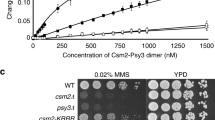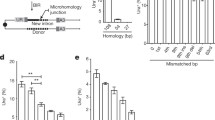Abstract
The Saccharomyces cerevisiae RAD51 and RAD54 genes are both required for the occurrence of homologous recombination and for the repair of double-stranded DNA breaks1. Previous studies have indicated that Rad51 protein, together with the single-stranded DNA-binding factor replication protein A (RPA), can promote the formation of heteroduplex DNA2,3,4, which is a key intermediate in homologous recombination1. Here we report the purification of the Rad54 protein to near homogeneity and the biochemical testing of its molecular function. We find that Rad54 protein possesses a double-stranded DNA-dependent ATPase activity, and that it interacts with the Rad51 protein. Addition of Rad54 protein to reactions containing Rad51 strongly stimulates the rate of pairing between homologous single-stranded and double-stranded DNA molecules. We conclude that Rad54 acts to overcome kinetic impediments that would limit homologous DNA pairing between recombining chromosomes in vivo.




Similar content being viewed by others
References
Petes, T. D., Malone, R. E. & Symington, L. S. in The Molecular and Cellular Biology of the Yeast Saccharomyces: Genome Dynamics, Protein Synthesis, and Energetics 407–521 (Cold Spring Harbor Laboratory Press, (1991).
Sung, P. Catalysis of ATP dependent homologous DNA pairing and strand exchange by the yeast Rad51 protein. Science 265, 1241–1243 (1994).
Sung, P. & Robberson, D. L. DNA strand exchange mediated by a Rad51-ssDNA nucleoprotein filament with polarity opposite to that of RecA. Cell 82, 453–461 (1995).
Sugiyama, T., Zaitseva, E. M. & Kowalczykowski, S. C. Asingle-stranded DNA binding protein is needed for efficient presynaptic complex formation by the Saccharomyces cerevisiae Rad51 protein. J. Biol. Chem. 272, 7940–7945 (1997).
Eisen, J. A., Sweder, K. S. & Hanawalt, P. C. Evolution of the SNF2 family of proteins: subfamilies with distinct sequences and functions. Nucleic Acids Res. 23, 2715–2723 (1995).
Emery, H. S., Schild, D., Kellogg, D. E. & Mortimer, R. K. Sequence of RAD54, a Saccharomyces cerevisiae gene involved in recombination and repair. Gene 104, 103–109 (1991).
Randerath, K. & Randerath, E. Ion-exchange chromatography of nucleotides on poly-(ethyleneimine)-cellulose thin layers. J. Chromato. 16, 111–125 (1964).
Pazin, M. J. & Kadonaga, J. T. Swi2/Snf2 and related proteins: ATP driven motors that disrupt protein–DNA interactions? Cell 88, 737–740 (1997).
Sung, P., Matson, S. W., Prakash, L. & Prakash, S. Rad3 protein of Saccharomyces cerevisiae is a DNA helicase. Proc. Natl Acad. Sci. USA 84, 6045–6049 (1987).
Shinohara, A. & Ogawa, T. Homologous recombination and the roles of double-strand breaks. Trends Biochem. Sci. 20, 387–391 (1995).
Kowalczykowski, S. C., Dixon, D. A., Eggleston, A. K., Lauder, S. D. & Rehrauer, W. M. Biochemistry of homologous recombination in E. coli. Microbiol. Rev. 58, 401–465 (1994).
Jiang, H.et al. Direct association between the yeast Rad51 and Rad54 recombination proteins. J. Biol. Chem. 271, 33181–33186 (1996).
Clever, B.et al. Recombinational repair in yeast: functional interactions between Rad51 and Rad54 proteins. EMBO J. 16, 2535–2544 (1997).
Formosa, T. & Alberts, B. M. Purification and characterization of the bacteriophage T4 uvsX protein. J. Biol. Chem. 261, 6107–6188 (1984).
Salinas, F. & Kodadek, T. Phage T4 homologous strand exchange: a DNA helicase, not the strand transferase, drives polar branch migration. Cell 82, 111–119 (1995).
Bezzubova, O., Silbergleit, A., Yamaguchi-Iwai, Y., Takeda, S. & Buerstedde, J. M. Reduced X-ray resistance and homologous recombination frequencies in a RAD54−/− mutant of the chicken DT40 cell line. Cell 89, 185–193 (1997).
Esser, J. R.et al. Disruption of mouse RAD54 reduces ionizing radiation resistance and homologous recombination. Cell 89, 195–204 (1997).
Acknowledgements
This work was supported by a PHS grant from the National Institute of Environmental Health Sciences.
Author information
Authors and Affiliations
Corresponding author
Rights and permissions
About this article
Cite this article
Petukhova, G., Stratton, S. & Sung, P. Catalysis of homologous DNA pairing by yeast Rad51 and Rad54 proteins. Nature 393, 91–94 (1998). https://doi.org/10.1038/30037
Received:
Accepted:
Issue Date:
DOI: https://doi.org/10.1038/30037
- Springer Nature Limited
This article is cited by
-
New insights into the mechanism of RPA in preserving genome stability
Genome Instability & Disease (2022)
-
Sister chromatid exchanges induced by perturbed replication can form independently of BRCA1, BRCA2 and RAD51
Nature Communications (2022)
-
In vitro role of Rad54 in Rad51-ssDNA filament-dependent homology search and synaptic complexes formation
Nature Communications (2019)
-
RAD54 N-terminal domain is a DNA sensor that couples ATP hydrolysis with branch migration of Holliday junctions
Nature Communications (2018)
-
Unique molecular mechanisms for maintenance and alteration of genetic information in the budding yeast Saccharomyces cerevisiae
Genes and Environment (2017)





